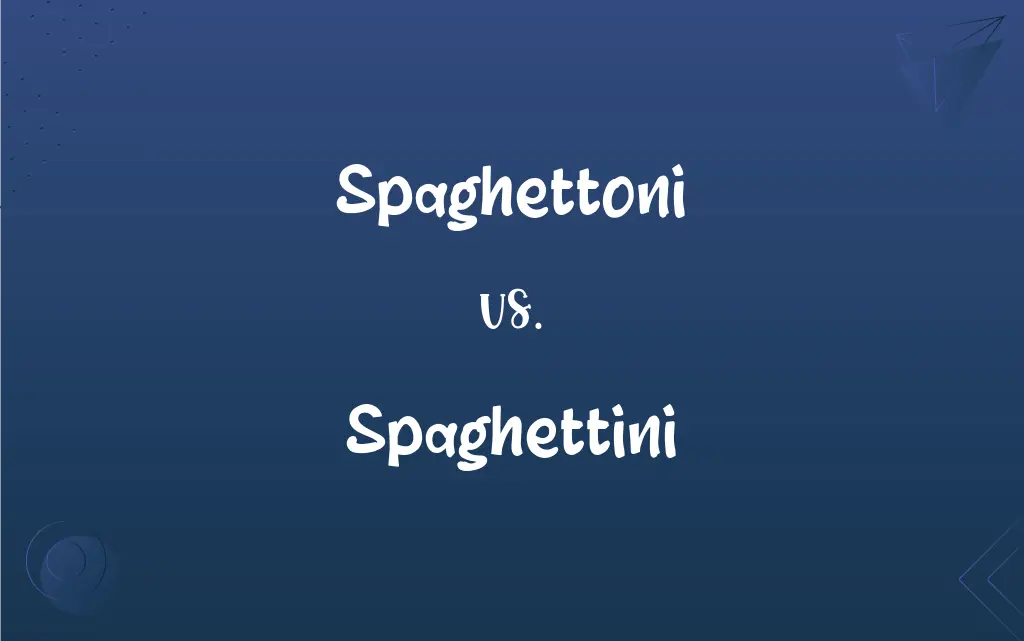Spaghettoni vs. Spaghettini: What's the Difference?
By Janet White || Updated on March 4, 2024
Spaghettoni is a thicker version of spaghetti, offering a chewier texture, while spaghettini is thinner, cooking faster and providing a more delicate bite.

Key Differences
Spaghettoni and spaghettini are both variations of the classic Italian pasta, spaghetti, distinguished primarily by their thickness. Spaghetti, known worldwide for its long, cylindrical shape, serves as the standard from which these two variants derive.
Spaghettoni is a thicker form of spaghetti, with a diameter that typically falls between 2.00 mm and 2.15 mm. This increased thickness contributes to a more substantial, chewier texture when cooked, making it well-suited for holding onto richer, heavier sauces. Spaghettini, on the other hand, is a thinner version of spaghetti, with a diameter usually ranging from 1.35 mm to 1.60 mm. This reduction in thickness results in a quicker cooking time and a more delicate texture, making spaghettini ideal for lighter, more refined sauces.
Both spaghettoni and spaghettini offer unique dining experiences and can be chosen based on the type of sauce and the desired texture in the finished dish. While they share similarities with traditional spaghetti, their differences in thickness and texture allow for a variety of culinary applications, catering to personal preferences and specific sauce pairings.
Comparison Chart
Thickness
Thicker (2.00 mm to 2.15 mm)
Thinner (1.35 mm to 1.60 mm)
Texture
Chewier
More delicate
ADVERTISEMENT
Cooking Time
Longer due to increased thickness
Shorter due to reduced thickness
Sauce Pairing
Suited for heavier, richer sauces
Best with lighter, more refined sauces
Ideal Dishes
Bolognese, hearty seafood sauces
Aglio e olio, light tomato-based sauces
Culinary Use
Absorbs more sauce, providing flavor
Complements subtle flavors without overwhelming
Spaghettoni and Spaghettini Definitions
Spaghettoni
Offers a satisfying mouthfeel in hearty dishes.
Spaghettoni pairs well with rich, creamy Alfredo sauce.
ADVERTISEMENT
Spaghettini
A thinner, more delicate variant of spaghetti.
Spaghettini with garlic and oil is a light, flavorful dish.
Spaghettoni
Ideal for absorbing and holding onto heavy sauces.
Use spaghettoni when preparing dishes with meaty sauces.
Spaghettini
Enhances the taste of refined sauces without overwhelming.
Spaghettini serves as the base for delicate seafood pasta.
Spaghettoni
A thicker version of spaghetti for a chewier texture.
Spaghettoni with Bolognese sauce offers a robust meal.
Spaghettini
Preferred for those seeking a subtle pasta texture.
Opt for spaghettini when making pasta with light oil-based sauces.
Spaghettoni
Requires longer cooking time to achieve perfect al dente.
Boil spaghettoni for 10-12 minutes for optimal texture.
Spaghettini
Cooks quickly, perfect for fast meals.
Spaghettini is ready in under 7 minutes, ideal for quick dinners.
Spaghettoni
Suited for those who enjoy a substantial pasta experience.
Choose spaghettoni for a filling pasta dinner.
Spaghettini
Best paired with simple, light sauces.
Toss spaghettini with fresh tomatoes and basil for a summer pasta.
Spaghettoni
A form of thick spaghetti.
Spaghettini
Pasta in long fine strands.
Spaghettini
A form of thin spaghetti
Spaghettini
Thin spaghetti
FAQs
Can I substitute spaghettoni for spaghettini in a recipe?
While substitutions can be made, the choice between spaghettoni and spaghettini should consider the sauce's thickness and desired dish texture.
What is spaghettoni?
Spaghettoni is a thicker variant of spaghetti, known for its chewy texture and suitability for pairing with rich sauces.
Why would I choose spaghettoni over spaghettini or vice versa?
Choose spaghettoni for heavier, richer sauces to complement its chewy texture, or spaghettini for lighter sauces to highlight its delicate nature.
What sauces pair best with spaghettoni?
Heavier sauces, such as Bolognese or creamy Alfredo, pair well with spaghettoni due to its ability to absorb and hold onto the sauce.
Can spaghettoni and spaghettini be used interchangeably with spaghetti in recipes?
Yes, but consider the sauce and desired final texture, as the thickness of the pasta significantly affects the dish's outcome.
What distinguishes spaghettini from traditional spaghetti?
Spaghettini is thinner than traditional spaghetti, offering a more delicate texture and faster cooking time, ideal for light sauces.
What are some traditional Italian dishes that feature spaghettoni or spaghettini?
Traditional dishes include spaghettoni with Bolognese sauce for a hearty meal and spaghettini aglio e olio for a simple, flavorful dish.
Can I make homemade spaghettoni or spaghettini?
Yes, with the right pasta maker attachments or manual tools, you can make homemade spaghettoni or spaghettini, adjusting the thickness to your preference.
How does the cooking time vary between spaghettoni and spaghettini?
Spaghettoni requires a longer cooking time due to its thickness, while spaghettini cooks more quickly because of its thinner strands.
Is spaghettini suitable for cold pasta dishes?
Yes, spaghettini's delicate texture makes it suitable for cold pasta salads, complementing light dressings and fresh vegetables.
Are spaghettoni and spaghettini gluten-free?
Traditional spaghettoni and spaghettini are made from wheat and are not gluten-free, but gluten-free versions made from rice, corn, or other gluten-free grains are available.
How do I achieve perfect al dente texture with spaghettoni or spaghettini?
For al dente pasta, boil spaghettoni or spaghettini according to package instructions, typically a minute less than the stated time, and test for firmness.
How should I adjust sauce quantities when using spaghettoni vs. spaghettini?
For spaghettoni, you may need slightly more sauce due to its thicker surface, while spaghettini, being thinner, might require less sauce to avoid overwhelming the pasta.
How do I store leftover cooked spaghettoni or spaghettini?
Leftover cooked pasta should be cooled quickly, stored in an airtight container, and refrigerated. It's best consumed within 1-2 days for optimal quality.
What is the origin of spaghettoni and spaghettini?
Both spaghettoni and spaghettini originate from Italy, where variations in pasta size and shape are common, each serving specific culinary purposes and regional preferences.
Are there any classic sauces that are traditionally avoided with spaghettoni or spaghettini?
Generally, very thick, chunky sauces may not cling as well to spaghettini due to its fine texture, while very light, watery sauces might be overpowered by spaghettoni's thickness.
Is there a nutritional difference between spaghettoni and spaghettini?
The nutritional content of spaghettoni and spaghettini is generally the same, with differences primarily in size and texture rather than in calories or nutrients.
How can I tell if my pasta is spaghettoni or spaghettini?
Measure the diameter of the pasta; spaghettoni is thicker (around 2.00 to 2.15 mm) compared to spaghettini (about 1.35 to 1.60 mm).
What are the best cooking practices for achieving the ideal texture in spaghettoni and spaghettini?
Use plenty of boiling, salted water to prevent sticking, stir occasionally for even cooking, and taste test near the end of cooking time to ensure pasta is al dente.
How does the choice between spaghettoni and spaghettini affect the presentation of a dish?
The choice can dramatically affect presentation; spaghettoni offers a heartier, more robust look, while spaghettini presents a more delicate, refined appearance, influencing the overall aesthetic and appeal of the dish.
About Author
Written by
Janet WhiteJanet White has been an esteemed writer and blogger for Difference Wiki. Holding a Master's degree in Science and Medical Journalism from the prestigious Boston University, she has consistently demonstrated her expertise and passion for her field. When she's not immersed in her work, Janet relishes her time exercising, delving into a good book, and cherishing moments with friends and family.
































































